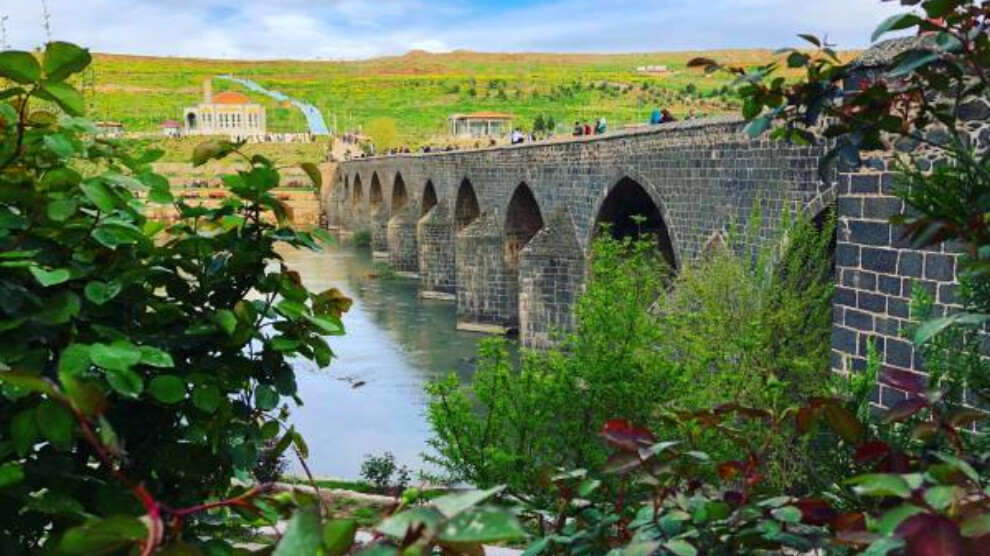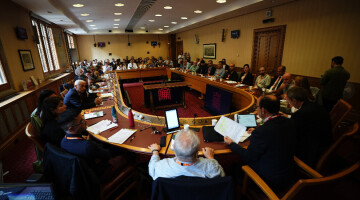The medieval city walls of Amed, more than five kilometers long and built by Assyrians five thousand years ago, and the eight thousand years old Hevsel Gardens are meant to be added to the List of World Heritage in Danger.
A draft report on the “State of conservation of properties inscribed on the World Heritage List”, which is expected to be finalized at the 45th session of the World Heritage Committee to take place from 10 to 25 September 2023 in Riyadh, Kingdom of Saudi Arabia, gives wide coverage to Diyarbakır Fortress and Hevsel Gardens Cultural Landscape.
According to Analysis and Conclusions of the World Heritage Centre ICOMOS and ICCROM, the 2022 Reactive Monitoring mission to the property reported that the property, its buffer zone and setting have undergone significant change since the inscription on the World Heritage List in 2015. Most of these changes are directly due to projects implemented by the State Party.
Highlights from the draft report include the following:
The absence of archaeologists during work on the City Walls and bastions, such as the adaptive reuse of the upper rooms of the towers, resulted in the loss of important fabric which could have contributed to the knowledge of the property. An ‘illegal’ neighbourhood and other legal infrastructure in the Citadel were demolished to create a public park, without any impact assessment study or investigation, such as to relocate the Roman amphitheatre previously reported in this vicinity, having been undertaken. Likewise, the demolition of poor-quality constructions from the 1930s at the Hz. Suleyman Mosque (Içkale) to develop a landscaped area was undertaken without archaeological surveys being undertaken.
Other projects since inscription have significantly eroded the OUV of the property, including numerous construction, landscaping and infrastructural projects, some reportedly illegal, in the setting of the TenEyed Bridge, resulting in the loss of its OUV.
Planned changes at the Anzele Spring may negatively impact the property’s OUV and, as with all projects that may affect the OUV of the property, they should be subject to a thorough assessment and details of the proposals and their associated impact assessments should be submitted to the World Heritage Centre for review by the Advisory Bodies, prior to any decision on their implementation which may be difficult to reverse.
The consolidation of land parcels of the Hevsel Gardens and the restructuring of the historic city inside the City Walls, with the consequent social impact, has resulted in the severing of the connection between the Gardens and the city they once nurtured, seriously damaging the OUV of the property. The mission cautions that other planned changes, such as the ongoing restructuring of the field patterns facilitating a change in the types of crops grown, will further threaten this key attribute, that urgent action must be taken to prevent further harm and that the relationship between the Hevsel Gardens, the City and its inhabitants should be reinstated.
Implementation of the 2016 Conservation Plan has continued despite the Committee’s repeated requests to the State Party to revert to the 2012 version of the Plan and to halt all projects that may affect the OUV of the property until the recommendations of the requested Reactive Monitoring mission are known and adopted by the Committee.
The mission reports that approximately 40% of Suriçi, the buffer zone component located inside the City Walls, has been demolished since inscription, resulting in further severe erosion of the property’s OUV. This erosion, through the implementation of untested projects, including the occasional invasive restoration of historic monuments, has taken place despite the Committee’s repeated concerns and in the absence of appropriate OUV-focused impact assessment procedures.
The recently constructed Vehicle Road and Touristic Tour Route has further disrupted the relationship of Suriçi and the City Wall.
The Reactive Monitoring mission concludes that the management system for the property is no longer effective and needs to be reviewed and re-established. It recommends the 2012 Urban Conservation Plan should be reinstated, as repeatedly requested by the Committee.
The mission concludes that the property is faced with imminent danger due to a significant loss of integrity, cultural significance and supporting historic urban fabric. The OUV of the property remains in danger from lawfully designed developments permitted under existing planning controls. The property faces a specific and ascertained imminent danger, including a serious deterioration of architectural and town-planning coherence and of the urban and rural space. The property is also faced with threats, such as the lack of a functioning conservation policy and the threatening effects of town planning, which could have deleterious effects on its inherent characteristics. The vulnerability of the integrity of the property has also been further exacerbated by the earthquake. All these factors combined lead the World Heritage Centre and the Advisory Bodies to maintain their view that the property continues to face ascertained and potential danger as defined in Paragraph 179 of the Operational Guidelines, and therefore, recommend its inscription on the List of World Heritage in Danger.
The World Heritage Committee expresses its deep concern that the State Party has not halted all projects that could affect the Outstanding Universal Value (OUV) of the property and has not reverted to the 2012 Conservation Plan, as repeatedly requested by the Committee, and also reiterates its request to the State Party to halt all projects that could affect the OUV of the property, including further demolitions and developments in its buffer zone, and to halt the continued implementation of the 2016 Conservation Plan and to revert to the 2012 Conservation Plan.
The Committee also expresses its deep concern about the changes brought about by the implementation of projects in the property and its buffer zone since its inscription, which have severely eroded its OUV, in particular:
a) In the functioning and morphology of the Hevsel Gardens, an integral part of the property and an essential attribute underpinning the property’s OUV,
b) The implementation of construction, landscaping and infrastructural projects in the immediate setting of the Ten-Eyed Bridge and the Tigris riverbanks, both within the property and its buffer zone,
c) The large-scale demolition and reconstruction or conversion of urban neighbourhoods in the property and its buffer zone, which has also led to a virtual destruction of the social relationship of the traditional local communities with the Hevsel Gardens and, despite this being a fundamental relationship that contributed to the OUV at the time of the inscription,
d) The construction of the Vehicle Road and Touristic Tour Route around the inner periphery of the City Walls,
e) The occasional inappropriate and invasive restoration of the monuments.
The Committee further reiterates its request to the State Party to:
a) Carry out independent Heritage Impact Assessments (HIAs) for urban design, landscape and infrastructural projects, as well as construction and restoration projects which may have an impact on the OUV of the property and its setting, in accordance with the Guidance and Toolkit for Impact Assessments in a World Heritage context.
b) Ensure that all projects are guided by suitable professional archaeological and conservation oversight, which should be fully integrated into all works to ensure good practice and effective outcomes.
c) Submit details of such projects and the associated HIAs to the World Heritage Centre for review by the Advisory Bodies prior to any decision on their implementation which may be difficult to reverse.
The Committee notes with great concern that the Management Plan for the property is still not fully implemented and has resulted in a range of disparate projects, some of which have and continue to undermine the OUV of the property.
The Committee considers that the property faces significant cumulative ascertained and potential threats, in particular due to a significant loss of integrity and cultural significance as well as a severe loss of the supporting historic urban fabric and a management system which has failed to maintain the attributes that convey its OUV.
The Committee decides to inscribe the Diyarbakir Fortress and Hevsel Gardens Cultural Landscape (Türkiye) on the List of World Heritage in Danger.
The Committee requests the State Party, in consultation with the World Heritage Centre and the Advisory Bodies, to develop a proposal for the Desired state of conservation for the removal of the property from the List of World Heritage in Danger (DSOCR) as well as a set of corrective measures, informed by the 2022 mission, including a timetable for implementation, to reverse the interventions on the property and its buffer zone and help mitigate the negative impacts that have resulted from development projects implemented since inscription, for consideration by the World Heritage Committee at its 46th session;
The Committee finally requests the State Party to submit to the World Heritage Centre, by 1 February 2024, an updated report on the state of conservation of the property and the implementation of the above, for examination by the World Heritage Committee at its 46th session.















